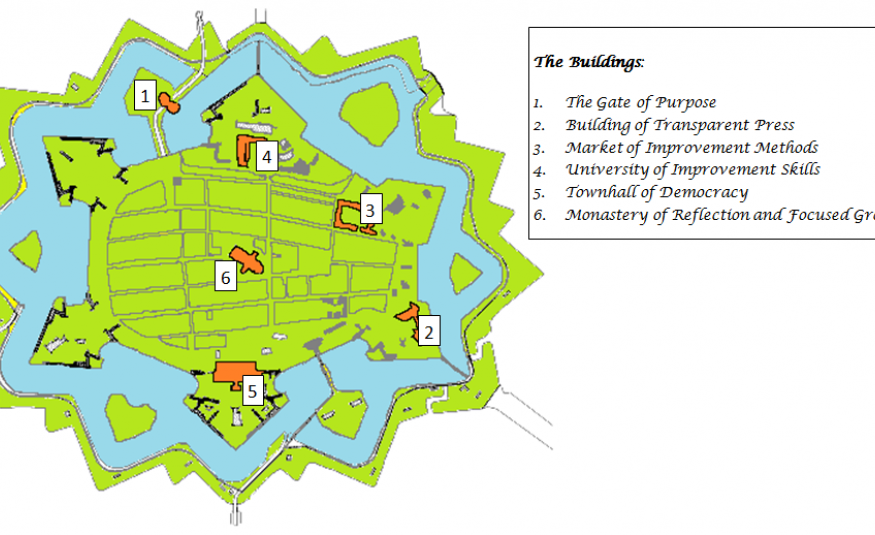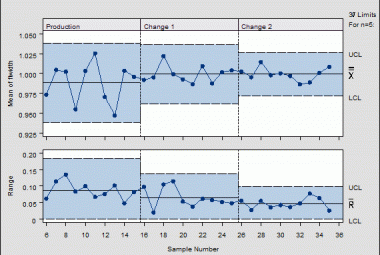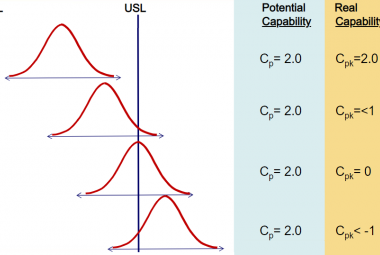To encourage employees to work together in improving business processes bottom-up, tools need to be introduced to facilitate them. This is what the market of methods stands for for. The Lean philosophy includes both technical and cultural aspects. It is important for the organization to choose the right tools fitting the specific situation the organization is in and encourage the right cultural aspects necessary to use the tools properly. Simply copying implementations of other factories seldom leads to extraordinary results. The Lean tools need to be built from within the organization, bottom-up, to make sure all employees learn how to use them properly.
The Lean tools which can be used are numerous, but can be divided in two categories: the basic tools which should be included in every Lean implementation (1) and the situational dependent tools, which are designed to find improvements in certain conditions (2). Next to the tools, the cultural aspects should encourage everyone in de organization of finding the next improvement.
The BASIC TOOLS I believe should be included in every Lean implementation have multiple purposes. They are the foundation of the complex situational dependent tools, but also the foundation for a culture of continuous improvement. For these tools, I designed the Lean House for the Shop Floor, which consists of four elements. Each of these methods are focused on including operators in the process of continuous improvement. They are 6S for an clean and orderly workplace, Standard Work to document the current way of working which are the starting point for improvement, the communication cells to facilitate communication both within and between departments, and the Kaizen-loop to encourage continuous improvement by everyone in the organization. All four of these tools help reducing both variation (Mura) as wastes (Muda). Everybody in de organization should be familiar with these four tools, and be part of their implementation. Everyone, operator or plant manager, can participate in the improvement program by creating a standard location for a certain part (6S) or find an error in the standard work sheet and correct it via Kaizen.
At my current employer, the four basic tools were implemented in a pilot first, after which other departments could implement the tools following their example.
The SUTUATION DEPENDENT TOOLS are the tools which are designed to visualize problems in product flow (Rother, 2010). Each of the tools are designed to help improve certain conditions. Kanban for instance can be a valuable tool in a discrete production plant with high variation of products and small batches. Kanban facilitates the reduction of Inventory and Overproduction, two of the 7 wastes. A Kanban system is less suited for the process industry, where only a small variation of products are produced in large batches.
Tools which are suited for the process industry are Heijunka (production leveling) and the complementing SMED to reduce change-over times. Using these tools will create possibilities to reduce batch sizes and shorten the interval in which a product is produced. This in turn leads to reduced inventories and shorter delivery times.
Next to improving production flow, improving machine productivity (Overall Equipment Effectiveness, OEE) can be valuable. One way of improving the OEE is to implement Autonomous Maintenance.
At my current employer, after all four tools of the Lean house of the shop floor are built, the more complex Lean tools are implemented. In our case these are – to date – SMED, Autonomous Maintenance and Heijunka.
The CULTURAL ASPECTS of the Lean philosophy has to do with the behavior employees make. Lean management is described as management by solving problems (M.Ballé, 2012) therefore lean behavior has to do with the speed in which problems are solved. Solving a problem is defined as implementing a preventative solution, to prevent de problem from ever occurring again.
Toyota has defined 14 management principles which represent their cultural values, which include “make problems visual”, “stop & fix the problem” and “everybody solves problems”(Liker, 2004). Working environments need to be a safe place for everyone to visualize problems when they arise for everyone to see and the possibility for operators to stop production when needed, to focus on really solving the problem (“stop and fix the problem”).
Tools are available to help all employees solve problems bottom-up. Kamishibai is a mini-audit tool which can be done by anyone in the organization, checking for small abnormalities in both process related as well as behavioral aspects. These abnormalities can be documented and improved using the Kaizen loop.
To coach and motivate employees in the organization to improve their workstation processes, management should conduct Gemba Walks. A Gemba walk basically describes a certain time frame in which a manager walks around the shop floor, asking operators about the problems they encounter in their daily work and how they can be of support in solving these problems. As a Lean manager, I have – to date – three Gemba walks of 2-3 hours a week planned on default, to make sure I always have enough time to talk to colleagues on the shop floor and really listen to what problems they encounter.
When organizational goals are properly cascaded down the company using Hoshin Kanri, and communication about accountability for ones actions is managed, an organization can design its own Lean Roadmap. Every roadmap should include the four basic lean tools from the Lean House of the Shop Floor (6s, standard Work, Communication Cells and Kaizen), after which situational dependent tools can be selected which are suited to visualize problems in product flow (SMED, Heijunka, Kanban, etc). Finally, management should facilitate bottom-up improvements by conducting gemba walks and Kamishibai checks, to support and coach operators in finding the next problem to solve, and thereby building a culture of continuous improvement.
This is article 4 in the series ‘The Fortress of Change‘
Continue to:
The University of Improvement Skills
REFERENCES:
Liker, J., 2004, The Toyota Way – 14 Management Principles From The world’s Greatest Manufacturer, New York: McGraw Hill. (summary)
Ballé, F.,Ballé, M. 2012, De Lean Manager – een roman over een Lean Transformatie, Driebergen (NL): Lean Management Instituut (summary)
Rother, M., 2010, Toyota Kata, Managing people for improvement, adaptiveness and superior results, USA: Mc Graw-Hill (summary)












